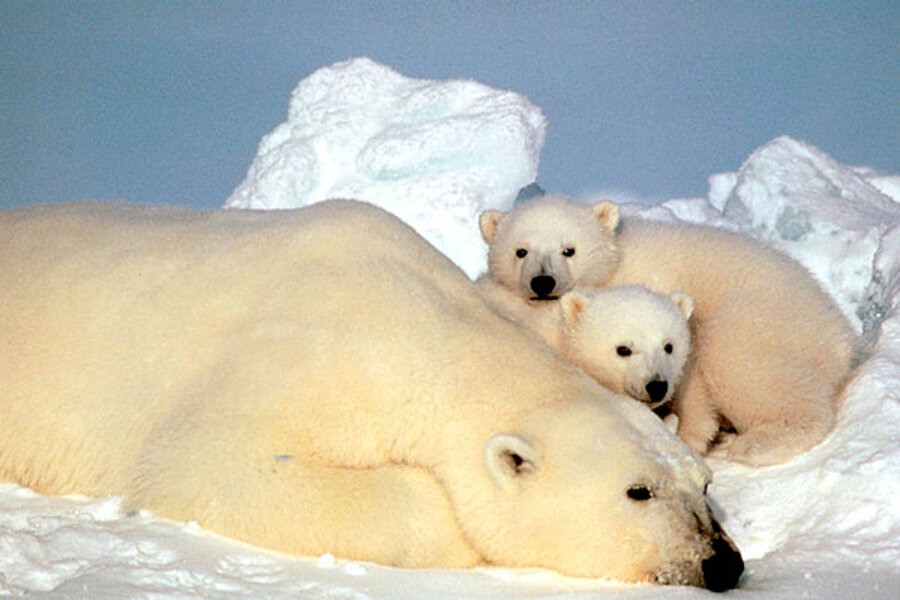Global warming a threat to polar bears? Judge orders review of US rule.
A US district court judge in Washington on Monday rejected arguments from environmental groups that the US Department of Interior was failing to protect polar bears because of its refusal to consider greenhouse gases as one of the threats facing the bears.
The environmentalists had hoped that a ruling in their favor would force the government to regulate greenhouse-gas emissions in order to comply with the Endangered Species Act (ESA). Most scientists agree that greenhouse-gas emissions are causing global warming, and that the rising temperatures are leading to the disappearance of Arctic Ocean ice, which is crucial to the health of polar bear populations.
Overall, the ruling highlights the challenge conservation groups can face as they turn to federal regulators to curb greenhouse-gas emissions.
But the judge did order the Interior Department to conduct a thorough environmental review of the rule that allows it to exclude greenhouse gases from its list of threats, noting that the department had failed to do so at the time the rule was initially considered.
Environmental groups had petitioned to have polar bears listed as threatened under the ESA in 2006. But when the Bush administration listed the bears in May 2008, it also adopted a "special rule" the following December.
Under that special rule, the department stipulated that only threats emanating from within the bears' current geographic range would be considered. Since greenhouse gases affecting climate come from sources around the globe, they fell outside the regulatory purview the special rule set.
Four environmental groups joined a lawsuit, holding that the exclusion was arbitrary, capricious, and illegal under the ESA, especially since the bears' listing cited climate change as a threat to the creatures' habitat. The coalition based much of its case on what it saw as the Interior Department's attempt to dodge its responsibility to regulate all threats to the bears, including greenhouse gases.
The Interior Department argued that since the overwhelming majority of greenhouse-gas emissions from human activities originate outside the polar bears' range, and the state of climate science doesn't allow for the level of precision needed to pinpoint and penalize individual emitters, the agency was in no position to add greenhouses gases to its regulatory mix.
In rendering his decision, US District Judge Emmet Sullivan acknowledged the groups' frustration at the lack of federal action to regulate greenhouse gases.
"The court is sensitive to the plaintiff's arguments for a strong mechanism to combat the effects of global climate change," Judge Sullivan wrote. But, he continued, the Interior Department argued that the Endangered Species Act was the wrong tool for protecting polar bears from the effects of global warming, "and the plaintiffs offered no compelling evidence to the contrary."
From the judge's perspective, the environmental groups did score a direct hit when they argued that the Interior Department failed to produce an environmental assessment for the special rule governing polar bears – an assessment required by the National Environmental Policy Act. Sullivan returned the rule to "interim" status and ordered the Interior Department to conduct an environmental assessment.
Both sides are due back in court by Nov. 17 to agree on a schedule the US Fish and Wildlife Service, which administers the ESA, will follow to conduct the assessment, notes Jason Rylander, senior staff attorney for Defenders of Wildlife in Washington, one of four environmental groups bringing the suit.
Some say they hope that the Obama administration will come to see why the ESA should be enlisted to deal with the climate threats to polar bear habitat.
The White House "always has the option of modifying [the special rule] or walking away from it in light of this new analysis," says Andrew Wetzler, director of the Natural Resources Defense Council's lands and wildlife program. The NRDC was one of the plaintiffs.
In the end, he says, the case places a spotlight on two attitudes toward greenhouse gases that could shape potential regulations.
If one considers global-warming pollution to be on a par with other forms of pollution, he says, then it's fair game to expect agencies that regulate other pollutants to regulate greenhouse gases, too.
If one considers greenhouse gases as unique forms of pollution, "then the answer is quite different," he says.
For now, as the question applies to the ESA, the answer seems to be: They are unique.





